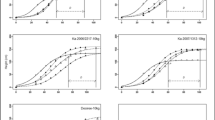Summary
In a field of commercially grown potatoes the yields of a late variety, Green Mountain, and of an early variety, Cobbler, were found to be inversely related to the numbers of golden nematode cysts found in the soil. In addition, the tuber yields were inversely related to numbers of immature females present on the roots of both varieties. These relationships existed when either total yields or U. S. Number 1 size yields were used. Green Mountain yields were reduced to a greater extent than were the yields of the Cobbler variety in the presence of high cyst populations in the soil and high immature female counts on the roots
Similar content being viewed by others
Literature Cited
Bainbridge, R. J.. 1946. Ulster guards against eel worm invasion. Farmers’ Weekly 24(12): 32–33.
Cannon, Orson S.. 1941. Potato nematode disease. Nassau County Farm and Home Bureau News. 27: 3.
Chitwood, B. G., Clement, R. L., and Gordon, F. M. 1942. Nematode diseases of potatoes. Suffolk County Farm Bureau News. 28: 16–18.
—. 1944. Progress report on the status of the golden nematode of potatoes in Nassau County, Long Island, New York. Nassau County Farm and Home Bureau News. 30: 1–3.
—, and Feldmesser, J. 1948. Golden nematode population studies. Proc. Helminth. Soc. of Wash. 15: 43–55.
Goffart, H.. 1933. Ueber die biologie and bekampfung des kartoffelnematodenHeterodera schachtii Schmidt. Arb. a. d. Biol. Reichsanst. f. Land. w. Forstwirt. 21: 73–108.
Haasis, F. A., and White-Stevens, R. H. 1944. Unpublished data.
Holmberg, C. 1946. Potatiskrafta och potatisal i Sverige ar 1944. Vaxtskyddsnotiser 1: 12–13.
Johnson, L. R. and Thompson, H. W. 1946. Potato root eelworm in Yorkshire. Great Britain Jour. Min. Agr. 52: 266–270.
Leiper, R. T. 1940. The potato eelworm problem of today. Jour. Roy. Agr. Soc. (England) 100: 63–73.
Miles, H. W., and Miles, M. 1945. Potato eelworm in Worcestershire. Worcestershire Agri. Chron. 13: 129, 131, 133, and 135.
Oostenbrink, M. 1950. Het Aardappelaaltje, Versl. en Med., Plant. Dienst. (Holland) 115: 230 p. June.
Smith, A. M. and Prentice, E. G. 1929. Investigation onHeterodera schachtii in Lancashire and Cheshire. Part I. The infestation in certain areas as revealed by cyst counts ; an estimation of the errors involved in the technique and a correlation with intensity of disease. Ann. Appl. Biol. 16:324–339.
Thompson, H. W. 1949. The potato eelworm in Yorkshire. Yorkshire Agri. Soc. Jour. 100: 36–43.
Wood, J.. 1946. Potato root eelworm — a survey in Holland. Kirton Agr. Jour. 11:43–48.
Author information
Authors and Affiliations
Rights and permissions
About this article
Cite this article
Mai, W.F., Spruyt, F.J., Lear, B. et al. Yields of green mountain and cobbler potato varieties grown on golden nematode infested soil. American Potato Journal 28, 617–625 (1951). https://doi.org/10.1007/BF02851276
Accepted:
Issue Date:
DOI: https://doi.org/10.1007/BF02851276




